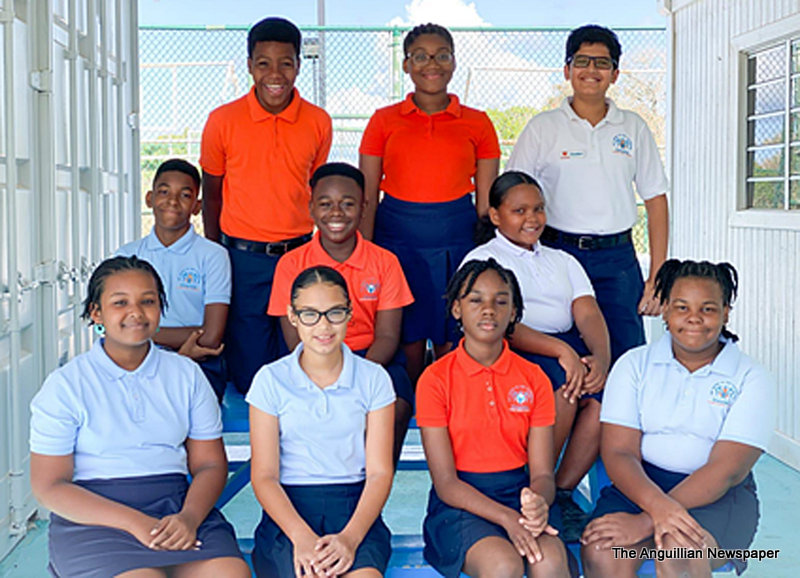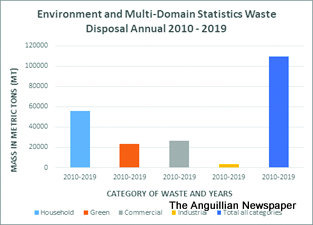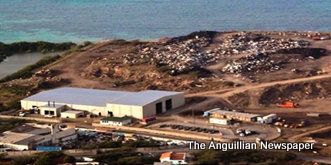
Everyday our earth is becoming more and more polluted with human activities: garbage, household waste and toxins that are being generated by the many households, businesses and health facilities in Anguilla. Have you ever stopped to think about all the trash and pollutants that fill our landfill – the effects it has on the environment, the people and our groundwater system? It contaminates our environment and affects our groundwater causing the water in the aquifer to become polluted. An aquifer is any natural formation of underground water. It is usually used to supply water for wells, springs etc. In recent years, Anguilla’s aquifer has increased in nitrate concentrations. As a result our groundwater supply is becoming more unsafe for consumption. This article addresses the impact of the Corito landfill on the aquifer, and proposes some realistic solutions to lessen the impact of disposable waste on the aquifer.
The impact of landfills on groundwater
As rain falls on landfill sites, the organic and inorganic materials are dissolved, forming a highly toxic leachate (a pollutant caused by decomposed waste and precipitation), as explained by Canterbury Environmental Education Centre. This leachate collects at the base of the landfill and usually contains high levels of toxic metals, ammonia, toxic organic compounds and pathogens. Any leakage or escape of this leachate can result in serious contamination of the local groundwater.
Since Anguilla has such thin soil it is very easy for leachate to pass through it, even though there are specialized draining systems. It is not guaranteed that all the leachate is collected meaning that there may still be leachate that can contaminate the groundwater. When our groundwater is contaminated it will affect the citizens and residents of the island when consumed. Some effects of such consumption are vomiting, drowsiness, and skin rashes.
Anguilla has limited sources of water, and groundwater is one of them. Groundwater is an important source of water for irrigation which means if it is contaminated and is used by farmers to water plants, the crops will not be safe to eat and they can or will harm us. In addition, unfiltered or untreated leachate from landfills can leak into soil and contaminate it causing the soil to be infertile. This is why it is very important to filter or boil groundwater before it is consumed. To ensure contaminated soil does not harm our food, farmers should grow plants in pots or crates so the soil wouldn’t absorb the contaminated groundwater.
How can we best utilize landfills?

Landfills contribute majorly to the worldwide problem of land pollution. These areas of land, otherwise known as dumping grounds, are some of the most common places for waste disposal. At the moment, Anguilla only has one landfill site called Corito. This establishment occupies a reasonably large acreage of the land along Anguilla’s southern coast. The waste disposal of Anguilla is categorized as household, green, commercial and industrial. The Corito landfill is currently overused which means citizens need to think of ways to minimize the household waste that is produced on a daily basis. Most household waste comprises of liquid waste, solid rubbish, organic waste, recyclable waste and hazardous waste, such wastes are harmful to the environment. Below is a graph that highlights the category and quantity of waste disposal in Anguilla. It can be seen that household waste is a large proportion of waste disposal.
Landfills have many negative impacts on the environment. Some of these include health threats, toxic gases that contaminate the air and sewage leaking. Anguillians can help stop these negative effects by reducing the amount of waste and debris that is produced. They should cultivate the habit of reusing plastic materials and bags. This can help reduce large amounts of land pollution. As we decrease the amount of garbage, eventually such a large area of land will not be needed to store our trash. These areas of land can be restructured and turned into new areas of land to expand different sites on the island. Making different items out of the debris is also very important. Coffee cups can be used as storage containers, milk jugs as watering cans, old wipe containers as dispensers for various items etc. There are many ways we can use our everyday resources to make new supplies for a green living lifestyle. Anguilla is a very beautiful island but has the potential to become even more beautiful with the help of the citizens.
Ways in which families can reduce solid waste
Solid waste is trash or waste containing everyday supplies that are discarded by the public and are a threat to the environment. Decreasing the amount of solid waste that is thrown away reduces the amount of waste in the landfill. Ways we can reduce solid waste is by practicing the three Rs: reduce, reuse, recycle:
? REDUCE: Reduce means to decrease the amount of solid waste. For example, instead of buying a large amount of small water bottles you can buy one big water bottle.
? REUSE: Reuse means to use the item that you want to throw out again if it can be used. For example, if you have plastic juice bottles that no longer have juice in them, they can become your child’s water bottles for school since we are always misplacing our bottles.
? RECYCLE: Recycle means to use your item that you are going to discard to make a new product that uses the material. For example, old vehicle tires can be used to make creative playground equipment.
Excessive waste leads to a high volume of garbage disposal which ends up at the Corito landfill. This further increases the nitrate concentration in the aquifers by way of leakage thereby creating a ripple effect on the health of Anguillians. Some chronic and other illnesses are considered to be a result of the poor quality of water we drink. The need to reduce our waste on the environment is important in achieving the sustainable development goal of a safer, cleaner environment.
How can Anguillians plan sustainably to reduce and properly dispose of household waste?

The world has faced dramatic changes within the last century. We use mobile phones, computers, cars and many other modernized products. Enhanced healthcare allows us to live long healthy lives. But development can also lead to many issues: more energy is needed so more energy is exhausted, more land is cleared for agriculture and accommodation etc. We create more waste and pollution. In order to prolong life and health for future generations, we must plan sustainably. This means we must use resources wisely and cautiously. It is necessary to use these resources in ways that allow them to replenish themselves.
People often throw their waste into the bin without thinking – where does it go and what do they do with it? Well, It goes to Corito but what do they do with the solid waste? They hurl some dirt over it and call it a day. But what really happens to it? Sometimes chemicals such as oils, gasolines and road salts seep down into the soil and enter the groundwater. This creates a contaminant plume in the aquifers. Movement of the contaminated groundwater in the aquifer spreads it over a wider area. This makes the groundwater unsafe for families across the island to use.
In order to protect Anguilla’s aquifers, we need to find ways to deal with the amount of household waste that is produced everyday. If you have potato peels and papaya skins don’t throw them in the trash – make compost for plants. If you have a plastic bottle don’t throw it away – reuse it to make craft items. If you have a big empty detergent bottle don’t throw it out – turn it into a plant potter. Overall, there are many ways to deal with our waste but what is most recommended are the 3 R’s, reduce, reuse and recycle.
We are now aware that Anguilla’s aquifers are in serious trouble and there cannot be a sustainable Anguilla without reducing, reusing and recycling waste for a safer, cleaner Anguilla. It is very important for the citizens of Anguilla to practice proper waste management, and be educated about this issue while planning sustainably in order to save our ‘tranquility wrapped in blue’. Here are three practical and realistic ways to save our aquifer:
- Going green – establish green spaces while encouraging citizen to practice composting
- Establish an effective recycling system that will include the participation of all households
- Develop modern water treatment systems focusing on reverse osmosis and ultrafiltration methods.
Special thanks to the Environmental Health Unit – Department of Health Protection and Anguilla Statistics Department. This article would not have been possible without their help.







